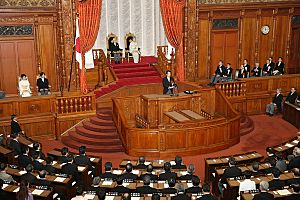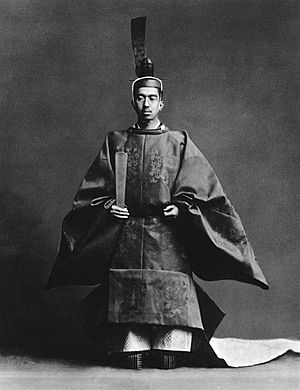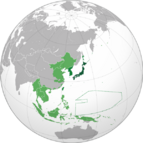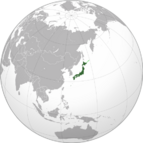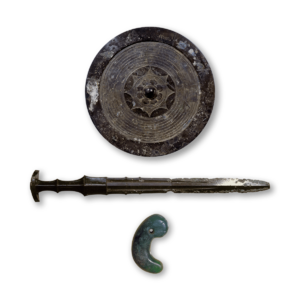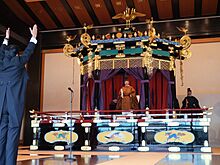Emperor of Japan facts for kids
Quick facts for kids Emperor of Japan |
|
|---|---|
| 天皇 | |
|
Imperial
|
|

|
|
| Incumbent | |
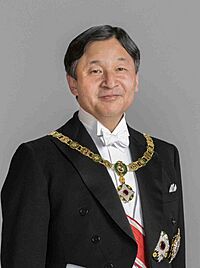 |
|
| Naruhito since 1 May 2019 |
|
| Details | |
| Style | His Majesty |
| Heir presumptive | Fumihito |
| First monarch | Jimmu (mythical) Tenmu (first monarch contemporaneously documented as using the title Tennō) |
| Formation | February 11, 660 BC; 2684 years ago (mythical) |
| Residence | Tokyo Imperial Palace (official residence) |
The Emperor of Japan (called Tennō in Japanese) is the hereditary monarch and head of state of Japan. The Emperor is a symbol of the Japanese state and the unity of its people. His position comes from the "will of the people," meaning the people hold the main power. The Imperial Household Law explains how the next emperor is chosen. The Emperor is also seen as the head of the Shinto religion. Shinto believes he is a direct descendant of the sun goddess Amaterasu. Traditionally, the Emperor's role began in the 7th century BC. However, the first emperors confirmed by history appeared around the 5th or 6th centuries AD.
The Emperor's role has changed a lot over time. Sometimes he was a powerful ruler, and other times he was mostly a ceremonial symbol. Since the first shogunate started in 1192, Japanese emperors rarely led armies in battle. They were almost always influenced by outside political groups. Between 1192 and 1867, the shōguns (military leaders) or their regents were the real rulers of Japan. Even though the Emperor officially appointed them, the shoguns held the power.
After the Meiji Restoration in 1868, the Emperor became the main source of power in Japan. This was written in the Meiji Constitution of 1889. However, since the 1947 constitution, the Emperor's role is mostly ceremonial. He is the head of state but has no real political power. The Emperor leads the Japanese honors system. He gives out awards and medals in the name of the state, following advice from the government.
Since the mid-1800s, the Emperor and other members of the imperial family have lived at the Tokyo Imperial Palace. This palace is located where Edo Castle used to be, in the heart of Tokyo. Before this, emperors lived in Kyoto, the old capital, for almost 1,100 years. The Emperor's Birthday (currently February 23) is a national holiday in Japan.
Naruhito is the current Emperor of Japan. He became Emperor on May 1, 2019. This happened after his father, Emperor Akihito, stepped down. Naruhito is the only remaining monarch in the world who holds the title of Emperor.
Contents
Understanding the Emperor's Role
In many countries with a king or queen, the monarch officially holds executive power. However, these monarchs usually follow the advice of elected officials. Japan is different. The Constitution of Japan clearly states that the Cabinet holds executive power. The prime minister leads the Cabinet.
The Emperor is also not the commander-in-chief of the Japan Self-Defense Forces. This power belongs to the prime minister. Still, the Emperor is recognized internationally as Japan's head of state.
The Emperor's main job is to be "...the symbol of the State and of the unity of the People." His position comes from the will of the people. He performs "acts in matters of state" as described by the Constitution. He does not have political power. These acts are done only with the advice and approval of the Cabinet. The Cabinet is responsible to the Diet (Japan's parliament) and the people.
However, the Emperor does have some rights in state matters. He has the right to be consulted before decisions are made. He can also encourage or warn the Cabinet about certain policies. These roles help keep Japanese democracy stable. They also help create a shared national identity. To remain neutral, the Emperor is not allowed to make political statements.
The Emperor's most important duty is to appoint the prime minister. The Diet chooses the prime minister. He also appoints the chief justice, chosen by the Cabinet. The Emperor cannot refuse these choices.
Other duties of the Emperor, listed in Article 7 of the Constitution, include:
- Promulgating (officially announcing) constitutional amendments, laws, and treaties.
- Calling sessions of the Diet.
- Dissolving the House of Representatives.
- Announcing general elections for members of the Diet.
- Confirming the appointment and dismissal of ministers and other officials.
- Confirming amnesty (forgiveness of crimes) and restoration of rights.
- Awarding state honors.
- Confirming international agreements.
- Receiving foreign diplomats.
- Performing ceremonial functions.
Regular ceremonies involving the Emperor include the Imperial Investitures at the Tokyo Imperial Palace. Another is the Speech from the Throne ceremony in the House of Councillors at the National Diet Building. This speech opens regular and special sessions of the Diet.
Cultural Importance
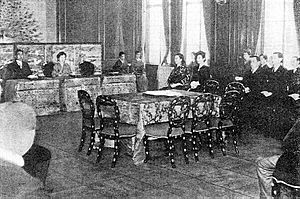
The Emperor is considered the most important Shinto priest. This sacred duty comes from the Niiname-sai festival. In this ritual, the Emperor offers newly harvested rice to the gods. A special version of this, called Daijōsai, happens in the first year after a new emperor takes the throne. This ceremony is mentioned in the Nihonshoki text from 720 AD. Today, a similar celebration is known as the Day of Thanksgiving for Labour.
The Emperor's role also involves preserving Japanese traditions and culture. For example, the Utakai Hajime is an annual poetry competition led by the Emperor. The Empress and other imperial family members support this role. They are honorary patrons of many groups and travel across the country for these duties.
In sports, the Emperor's Cup is a trophy given in various competitions. These include football, judo, volleyball, and sumo tournaments.
A Look at History
The Emperor has always been a symbol of Japan's long history. However, the amount of power the Emperor held has changed greatly over time.
Early Beginnings
According to old Japanese stories, Emperor Jimmu founded Japan many centuries ago. But most modern experts believe Jimmu and the first nine emperors are mythical figures. Emperor Sujin, the 10th emperor, might have been a real person. Emperors from Emperor Ōjin onward are thought to be historical. The reign of Emperor Kinmei (around 509–571 AD) is the first for which we have reliable dates.
Ancient tombs called kofun (built between the 3rd and 7th centuries AD) might hold clues about early Japanese rulers. However, the Imperial Household Agency has usually not allowed archaeologists to open these tombs. They say they want to respect the spirits of past emperors. In 2016, the agency started allowing some limited research into a few kofun.
In the early 7th century, the Emperor began to be called the "Son of Heaven" (tenshi). This title was borrowed from China. It was later used for earlier legendary Japanese rulers.
Power Struggles (10th Century)
The rise of the samurai class from the 10th century slowly weakened the imperial family's power. This led to a period of instability. Emperors sometimes clashed with the ruling shogun. For example, Emperor Go-Toba rebelled in 1221 against the Kamakura shogunate. Also, the 1336 Kenmu Restoration under Emperor Go-Daigo showed the power struggle between the Imperial Court in Kyoto and the military governments.
Shoguns Take Control (530s–1867)
For a long time, seven non-imperial families controlled the Japanese emperors. These included the Soga clan, Fujiwara clan, Taira clan, Minamoto clan, Hōjō clan, Ashikaga shogunate, and Tokugawa shogunate. However, every shogun had to be officially recognized by the emperors. The emperors were still seen as the source of power, even if they couldn't use it freely.
From 1192 to 1867, the shōguns or their regents held the real political power. Their authority came from the Emperor's official approval. When Portuguese explorers first arrived in Japan, they compared the Emperor to the Pope. They saw the Emperor as having great symbolic power but little political power. They compared the shogun to European rulers.
Kenmu Restoration (1333–1336)
In 1333, Emperor Go-Daigo managed to regain direct power. He overthrew the Kamakura shogunate with the help of Ashikaga Takauji. This short period (three years) when the Emperor ruled directly is called the Kenmu Restoration. However, the Emperor's direct rule was not effective and failed. Takauji then took political power for himself.
Meiji Restoration (1868)
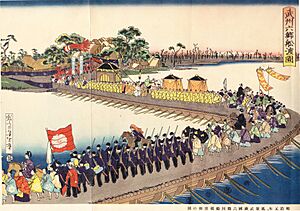
In July 1853, Commodore Perry's "Black Ships" from the US Navy arrived in Edo Bay. Japan was not strong enough to stop them. Japan was forced to open up to foreign trade through unfair treaties. The shogunate could not handle these foreign visitors. Because of this, Emperor Kōmei began to assert himself more politically.
By the early 1860s, the relationship between the Imperial Court and the shogunate changed greatly. People who were unhappy with the shogunate rallied around the slogan sonnō jōi ("revere the emperor, expel the barbarians"). The Satsuma and Chōshū regions, old enemies of the Tokugawa shogunate, united. They won an important military victory near Kyoto against Tokugawa forces.
On November 9, 1867, Shogun Tokugawa Yoshinobu officially stepped down. This restored Emperor Meiji to nominal full power. The Meiji Constitution was adopted on February 11, 1889. The Emperor of Japan became an active ruler with significant political power. This power was shared with an elected Imperial Diet. Japanese citizens gained many rights and duties.
The constitution said the Emperor was "the head of the Empire." He combined "the rights of sovereignty" and exercised them according to the Constitution. His rights included approving laws and being the "supreme commander of the Army and the Navy." When Emperor Meiji died in 1912, his son Taishō became Emperor. Because Taishō had health issues, many of these powers were taken over by the Imperial Diet. This period was known as the Taishō Democracy.
World War II (1937–1945)
Emperor Shōwa (Hirohito) was the Emperor during the Pacific War. He controlled both the state and the imperial forces. His role as head of the State Shinto religion was used during the war. This created an Imperial cult that led to extreme devotion, like kamikaze bombers. After Japan surrendered, the Allies issued the Shinto Directive. This separated religion and state in Japan.
In 1946, Emperor Shōwa had to make the Humanity Declaration. In this declaration, he used a special word that some experts believe did not fully give up his divine status. Scholars still debate how much power he had and what role he played during World War II. Emperor Shōwa's reign from 1926 to 1989 was the longest for any Japanese emperor.
Modern Era (1978–Present)
Japanese Emperors have not visited Yasukuni Shrine since 1978. Emperor Hirohito stopped visiting after learning that Class-A war criminals were secretly honored there. His son, Akihito, and grandson, Naruhito, have continued this boycott.
By 1979, Emperor Shōwa was the only monarch in the world with the title "Emperor." He was the longest-reigning monarch in Japan's history.
Journalist Makoto Inoue believes that Emperor Emeritus Akihito wanted to be closer to the people. He did not want to be treated like a god or a robot. Inoue thinks Akihito changed the symbolic role of the emperor into a more human one. In March 2019, a survey reported that 87% of people thought Akihito fulfilled his role as a symbol of the state well.
On April 30, 2019, Emperor Akihito stepped down due to health issues. This ended the Heisei era. The last time an emperor stepped down was Emperor Kōkaku in 1817. Akihito's oldest son, Naruhito, became Emperor on May 1, 2019. This began the Reiwa era.
Current Constitution
In 1947, the post-war Constitution of Japan became law. It created a parliamentary system of government and guaranteed basic rights. Under this constitution, the Emperor of Japan is "the symbol of the State and of the unity of the people." He has a purely ceremonial role and does not hold sovereignty (supreme power). This constitution was created under the Allied occupation after World War II. It replaced the older Meiji Constitution, which gave the emperor almost unlimited powers. The current constitution is a strong document and is the oldest unchanged constitution in the world.
Japan's Realm and Territories
Historically, the Emperor's position did not depend on specific territories. Instead, it was about his symbolic and religious authority. Since the Kamakura shogunate, the Emperor officially owned the realm. For most of medieval Japan, the shogun's power came from being appointed by the Emperor. Even though the shogun was the real ruler, he needed the Emperor's approval. The Emperor was seen as a direct descendant of Amaterasu and was very important in the Shinto religion. So, no shogun tried to take the Emperor's place. They tried to control him and keep him out of politics.
The Emperor still had the power to "control time" through the Japanese Nengō system. This system names eras on calendars after emperors.
During the Kofun period, the first central government was in Yamato. Japan's territory has changed throughout history. Its largest size was the Empire of Japan. In 1942, it covered about 8.5 million square kilometers. After its defeat in World War II, the empire was broken up. Today, Japan's territories include the Japanese archipelago and other areas. No matter how the territory changed, the Emperor remained the formal head of state of Japan. For most of history, real power was held by shoguns or prime ministers. The Emperor was more like a respected symbol of divine harmony. The current parliamentary government continues this arrangement with the Emperor.
The name Nihon (Japan) was first recorded between 665 and 703 AD. This was centuries after the imperial line began. The different names for Japan do not change the Emperor's status as head of state.
Imperial Education
Historically, emperors had special education officers. For example, Emperor Taishō had Count Nogi Maresuke as his tutor. Emperor Shōwa had Marshal-Admiral Marquis Tōgō Heihachirō. Emperor Akihito had Elizabeth Gray Vining and Shinzō Koizumi. Members of the imperial family were required to attend the Gakushūin (Peer's School) until 1947.
Marriage Traditions
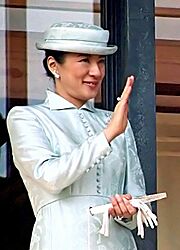
Throughout history, Japanese emperors and noblemen chose one main wife. They did not just have many female attendants.
The Japanese imperial family often practiced official polygamy (having more than one spouse) until the Taishō period (1912–1926). Besides his empress, the emperor could have several secondary wives (concubines). Sons born to these secondary wives were usually recognized as imperial princes. Such a son could become heir if the empress did not have a son.
Of the eight reigning empresses of Japan, none married or had children after becoming empress. Some were widows who had children before their reigns. Children of the empress were preferred over sons of secondary wives for succession.
The oldest tradition for imperial marriages involved marrying within the imperial family. This included marriages between half-siblings or between an uncle and niece. These marriages were thought to keep the imperial bloodline pure. They also aimed to unite different branches of the imperial family. Daughters from other families were usually concubines. This changed when Emperor Shōmu (701–706) made his Fujiwara consort, Empress Kōmyō, his chief wife. This was a very rare event at the time.
Japanese monarchs, like others around the world, needed to form alliances with powerful leaders. Many alliances were sealed through marriages. However, in Japan, these marriages soon became strict traditions.
From the 7th and 8th centuries, emperors mainly married women from the Fujiwara clan. These women were most likely to become mothers of future monarchs. This was seen as a tradition of marriage between descendants of two kami (Shinto deities). One was Amaterasu (from the imperial family) and the other was the Fujiwara family's kami. This arrangement suited powerful Fujiwara lords. They gained influence by providing brides for the imperial family. These arrangements led to the tradition of regents, who were always Fujiwara lords.
Before this, emperors married women from the powerful Soga clan or from within the imperial family. These marriages often helped secure alliances or succession. For example, a Soga lord might ensure his control over a prince who would become a puppet emperor. Or a prince might combine two imperial bloodlines to strengthen his claim to the throne.
Over time, emperors could only marry women from a small group of approved families. This tradition became very strict. Only rarely did a prince become emperor if his mother was not from these approved families. The Meiji-era Imperial Household Law of 1889 made this rule official. It said that only daughters of the five main Fujiwara branches and daughters of the imperial family were acceptable brides. This law was removed after World War II. In 1959, the future Emperor Akihito was the first crown prince in over a thousand years to marry someone from outside this traditional circle.
Three Sacred Treasures
In Japanese mythology, the sacred treasures were given to Ninigi-no-Mikoto. He was the grandson of the goddess Amaterasu. Amaterasu sent him to Japan with three special gifts for the emperor. The story of Ninigi coming to Earth is in the Nihon Shoki. These Three Sacred Treasures have been passed down through Japanese emperors. They show that the emperor is a descendant of Amaterasu. The three sacred treasures are:
- Yata no Kagami (a mirror, kept at the Ise Grand Shrine)
- Yasakani no Magatama (a jewel, kept at the central shrine of the Three Palace Sanctuaries)
- Kusanagi sword (kept at the Atsuta Shrine)
During the succession ceremony, having the jewel, sword, and mirror proves that the emperor is the rightful ruler.
Imperial Succession
The Japanese imperial family claims to have "reigned since time immemorial." There are no records of an emperor who was not said to be a descendant of previous emperors. However, some suspect that Emperor Keitai (around 500 AD) might have been from a different family. But historical records say he was a male descendant of Emperor Ōjin. His descendants, including later emperors, were also related to imperial princesses from the older line.
For centuries, the Japanese imperial family had its own unique way of choosing the next emperor. It was not always based on the oldest son inheriting. Women were allowed to become empresses. However, their children had to be from a male member of the imperial family to inherit the throne. Adoption was also possible, but the adopted child had to be from another male member of the imperial family.
Emperors often stepped down from the throne. In fact, this happened more often than an emperor dying while still ruling. It was believed that after about ten years of service, an emperor deserved a peaceful retirement. Many Japanese emperors became rulers as children, some as young as 6 or 8 years old. Their religious duties were thought to be manageable for a child. Being a child also made it easier for powerful political figures to control them. Almost all Japanese empresses and many emperors stepped down once a suitable male descendant was old enough to rule. These traditions are often seen in Japanese stories and plays.
Before the Meiji Restoration, Japan had eleven reigns by empresses. All of them were daughters from the male line of the Imperial House. None became empress simply by being a wife or widow of an emperor. Imperial daughters often became empresses as a temporary solution. This happened if a suitable male was not available or if different imperial branches were competing. More than half of Japanese empresses and many emperors stepped down once a suitable male heir was ready.
The Meiji Constitution (1889) stated that only male descendants could inherit the throne. The 1889 Imperial Household Law made this clear. It specifically excluded female descendants. If the empress did not have a son, the emperor could have a concubine. The son born to the concubine would be recognized as the heir.
Article 2 of the current Constitution of Japan, from 1947, says that the Imperial Throne is passed down according to the Imperial Household Law. The Imperial Household Law of 1947 kept the rule that only male descendants can inherit. This law was created quickly to fit the new American-written Constitution. To control the size of the imperial family, the law states that only legitimate male descendants in the male line can be imperial family members. Imperial princesses lose their status if they marry outside the imperial family. Also, the emperor and other imperial family members cannot adopt children.
Current Succession Rules
Succession is now controlled by laws passed by the National Diet. The current law still prevents women from becoming empress. A change to this law was considered until Princess Kiko gave birth to Prince Hisahito.
Before Prince Hisahito's birth on September 6, 2006, there was a concern about who would be next in line. This was because Prince Akishino was the only male child born into the imperial family since 1965. After Princess Aiko was born on December 1, 2001, there was public discussion about changing the Imperial Household Law to allow women to inherit the throne. In January 2005, Prime Minister Junichiro Koizumi formed a special group to study changes to the law.
This group recommended on October 25, 2005, that the law be changed to allow females from the male imperial line to become empress. On January 20, 2006, Prime Minister Junichiro Koizumi promised to propose a bill allowing women to ascend the throne. However, shortly after it was announced that Princess Kiko was pregnant, Koizumi stopped these plans. Her son, Prince Hisahito, is third in line to the throne under the current law. On January 3, 2007, Prime Minister Shinzo Abe announced he would not pursue the proposal to change the law.
Another idea is to allow unmarried men from the abolished branches of the imperial family to rejoin. This would be an emergency measure to ensure stable succession. This would not change the Imperial Household Law itself.
Crown Prince Akishino was formally declared first in line to the Chrysanthemum Throne on November 8, 2020.
Burial Traditions
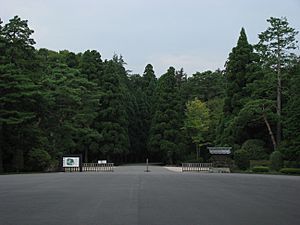
During the Kofun period, special funerals were held for dead emperors. We know more about the funeral rites from the end of this period. These involved a temporary resting place for the body before permanent burial.
Empress Jitō was the first Japanese imperial person to be cremated (in 703 AD). After that, most emperors were cremated until the Edo period. For the next 350 years, burial in the ground became the preferred funeral custom. Until 1912, emperors were usually buried in Kyoto. From Emperor Taishō onward, emperors have been buried at the Musashi Imperial Graveyard in Tokyo.
In 2013, the Imperial Household Agency announced that Emperor Akihito and Empress Michiko would be cremated after they die.
Imperial Wealth
Before World War II, the Japanese monarchy was considered one of the wealthiest in the world. Until 1911, there was no difference between the Emperor's official properties and his personal wealth. The Imperial Property Law of 1911 created two types of imperial properties: hereditary (crown) estates and personal properties.
Due to poor economic conditions in Japan, a large portion of crown lands (about 26% of the total) were sold or given to the government and private groups in 1921. In 1930, the Nagoya Castle was donated to the city of Nagoya. Six other imperial villas were also sold or donated. In 1939, Nijō Castle was given to the city of Kyoto.
By the end of 1935, the Imperial Court owned about 3.1 million acres of land. Most of this was the Emperor's private land. The total value of imperial properties was estimated at ¥650 million. This was in addition to the Emperor's personal fortune, which included many family treasures and investments in major Japanese companies.
After Japan's defeat in World War II, all the related branches of the imperial family were abolished. These families had to sell their assets. The number of staff in the imperial households was greatly reduced. The imperial estates and the Emperor's personal fortune were transferred to state or private ownership. Only about 6,810 acres of land remained.
Since the 1947 constitutional changes, the imperial family has been supported by official funds from the Japanese government. The largest imperial land transfers included former imperial forests and farms, which went to the Ministry of Agriculture, Forestry and Fisheries. Imperial property holdings have been further reduced since 1947. Today, the main imperial properties include the two imperial palaces in Tokyo and Kyoto, several imperial villas, and some imperial farms and game preserves.
As of 2017, Akihito's estimated net worth was US$40 million. The wealth and spending of the emperor and imperial family were kept private until 2003. That year, a journalist gained access to documents that revealed details of the imperial family's US$240 million budget in 2003. The book showed that the imperial family employed over 1,000 people. The total cost of events for Emperor Naruhito's enthronement in 2019 was about 16.6 billion yen (US$150 million). This was 30% higher than Emperor Emeritus Akihito's accession in 1990.
See also
 In Spanish: Emperador de Japón para niños
In Spanish: Emperador de Japón para niños
- Anti-monarchism in Japan
- Chrysanthemum taboo
- Controversies regarding the role of the Emperor of Japan
- Daijō Tennō
- Divine right of kings
- Emperor system
- Empress of Japan
- Family tree of Japanese monarchs
- Imperial House of Japan
- Japanese Air Force One
- Japanese honors system
- Japanese official state car
- List of emperors of Japan
- Reigning Emperor
- Sacred king
- State Shinto


